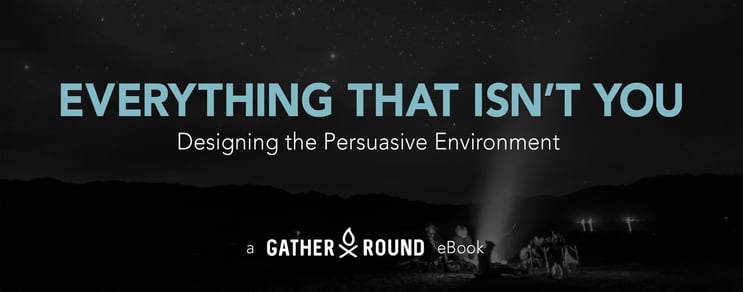
For the last few months, we've been studying the impact of the Persuasive Environment on presentations. By examining – and manipulating – factors of time, location and atmosphere, we can add deeper meaning to our messages, thereby moving audiences in ways we never thought possible.
What happens when we dig in and think of literally everything? What can we hope to accomplish by going to these lengths? Use this list of 11 actions as a resource – a reminder of what success looks like – when we're designing the Persuasive Environment.
The Persuasive Environment Will...
1. Highlight important pieces of the message.
Imagine the point in your presentation when you invite the audience to join you in your mission. This could be a very powerful moment, and a piece of your message you likely want them to remember. Could you:- Turn up the house lights, so audience members can see each other?
- Direct a spotlight on one specific individual, and ask her to commit publicly?
- Walk out into the middle of the audience, so they feel like you're "in it" with them?
All of these are possible, but only if you're intimately familiar with your environment and have taken the steps to manipulate it.
2. Influence attendance.
Want butts in seats? Treat it like a marketing assignment:
- Stage a "queue" at the event and wrap it around the corner. It will signal demand on your material and make people feel like they're missing out if they're not there.
- Consider how signage, brand cues and simple color blocking can pull audience members in the doors to your presentation.
3. Alleviate anxiety.
Don't let stomach bats ('cause they're not really butterflies, are they?) get the best of you. Leverage your environment to make it work for your nerves, not against them.
- Leave a podium or stool on the stage, but behind you. Don't plan to use it, but know it's there in case you have moments of weakness.
- Enter the room or stage to music that gets your (and your audience's) adrenaline pumping.
- Plant "anchor" people, with whom you're most comfortable, in strategic positions: The front row, the sides and the middle of the audience. When you scan the crowd, your eye contact with them will calm you, but your audience will feel like all are being addressed.
Keep in mind your audience is anxious too. They're waiting for you to tell them how to behave.
4. Remind audiences of a message.
Two points make a line. Three or more make a trend. How can the environment reinforce messages the audience should have heard by the time they arrive to listen?
When GatherRound worked with MOOYAH on their annual franchise conference, we wanted audience members to be anchored in their impact on their customers. We decorated the rooms with actual guest satisfaction feedback from restaurants all over the country, and it reminded franchisees that what they're doing truly matters.
5. Distract from the unimportant.
What do we want the audience to take away? By answering that question, we also answer its inverse: What don't we want them to hear? Consider how your environment can be adjusted to reach the full potential of your message by cutting out the unnecessary.
- Present "in the round" to ensure maximum focus on the most important variable: You.
- Light – and its absence – can be a very powerful device. Want to call attention to something? Literally shine a light on it. It'll make the rest of the room seem invisible.
6. Connect people – to you and to each other.
Room arrangement goes a long way in facilitating interaction, but it isn't the only way to connect to audience members. When you move throughout your space, eyeballs move with you. Find ways to get in the crosshairs so audience members make eye contact. They'll catch nods and looks of affirmation from one another and they'll feel reassured about you and your content.
7. Change the overall mood.
We don't always have the luxury of presenting to a room full of happy-go-luckies. Sometimes, things are tense, somber, or some other attitudinal elixir that puts your message at risk. Use the environment and bring the audience to where you need them to be.
- Play music with a fluid bass line, a 4/4 beat and a tempo between 150 – 190 beats per minute. They may not erupt into dance, but at least they'll feel like they should. A step in the right direction.
- Get outdoors. Sunlight is a proven dopamine stimulator, so when things look ugly, turn them ultraviolet.
8. Instruct the behavior you expect from your audience.
Why are early elementary classroom desks arranged in clusters? So the students can see each other and model their behavior after the most engaged. Why do churches have pews? To facilitate sitting and standing without chairs shuffling, and so all audience eyes point to the pulpit. Why do therapeutic groups convene with their chairs positioned in a U-shape? So the instructor can see the audience, but they can also see each other have breakthroughs and other emotional moments.
Seeing the pattern here? What behavior do you expect from your audience?
9. Reinforce other persuasive tactics.
Depending on your content, you might employ scarcity, social proof, authority or reciprocation to move your audience toward your ideas. How can your environment help?
- When it comes to scarcity, show, don't tell. How much breath does it require to explain "time is running out?" If you need your audience to act on the pollution at the park, persuade them at the park.
- Are you the authority on your topic? Do you know someone who is? If so, get to her turf. A persuasive discussion on the lasting psychological effects of standardized testing is much more effective in a lecture hall than a conference room. A sales presentation on HVAC technology might be better held on the roof of an office building than over coffee.
10. Provide anticipation, making the audience want more.
Tear a page out from Ellen's playbook. She often rests large, wrapped gifts on stage for entire segments at a time, causing audience members to shuffle to the edges of their seats for the reveal. Keep in mind, gifts don't have to have monetary value. They can be just as valuable in the form of time, fun and other more abstract returns.
11. Invigorate fading attention.
Many presenters assume "audience eyebrow" is a natural part of the job. They accept that 46% of our audience chooses to tune out, turning to mobile devices, or simply spacing out, within the first minute. But Persuasion Designers use the environment to their advantage instead. Lights, temperature, music and many other atmospheric factors act like environmental caffeine to audiences.
In Short:
Your idea, and what you need your audience to do with it, are simply too important to leave anything to chance. Taking advantage of time, location and atmosphere gives you control over some of the most important variables in your persuasion. Don't put your results at risk. Think of everything that isn't you. Design a persuasive environment.
For more on designing a persuasive environment, please download our free eBook.


